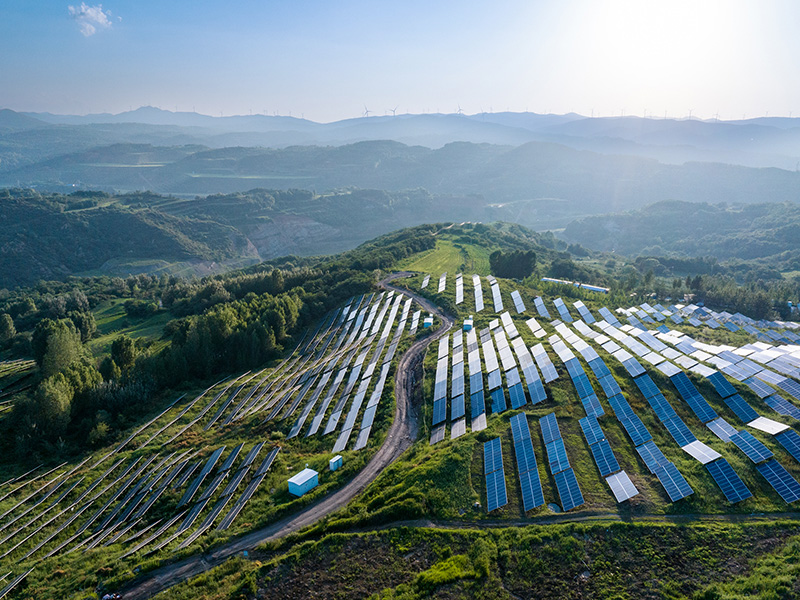
Photo by Alexander Kaunas on Unsplash
Authors
-
Lin Wang
Former Director, Transformation, BSR
-
Olivia Li
Former Manager, Transformation, BSR
Since the launch of China’s 14th Five-Year Plan (14th FYP) in early March, China’s climate commitments—to peak carbon emissions by 2030 and achieve carbon neutrality by 2060—have been the focus of discussion among global politicians, thought leaders, issue experts, and businesses. Increasing interest by the international community to partner with China on climate has followed this target, with opportunities for collaboration seen at the China-France-Germany virtual climate summit, the joint meeting and statement between U.S. and China climate envoys John Kerry and Xie Zhenghua, and the Leaders Summit on Climate.
“[The U.S. and China] intend to take appropriate actions to maximize international investment and finance in support of the transition from carbon-intensive fossil fuel based energy to green, low-carbon and renewable energy in developing countries.”
U.S.-China Joint Statement Addressing the Climate Crisis
At the same time, the business community seeks to understand the impact of these climate goals on the market. As we wait on details for local government policies and implementation plans, there are questions on how to understand ESG diligence and engagement in China.
However, the 14th FYP clearly states a direction with heightened focus on environmental, social and governance (ESG) issues, with a surge in homegrown demand for ESG in the financial market. “In 2019, inflows into ESG-theme ETFs in China totaled US$20.5 billion, versus US$4.9 billion in 2018,” according to a report by Ping An, “ESG investments also outperformed.”
Consequently, a significant shift in energy markets, technology solutions, and innovation will be needed to enable China’s changes. This shift will require the full commitment and participation of investors and lenders to ensure that financial flows move in support of China’s heightened focus on ESG and help to accelerate the journey toward a net zero economy.
What does the FYP mean for investors? Where do ESG topics anchor when looking at investments in China? What are the risks and opportunities, and how might an investor engage its potential portfolio companies?
To answer all these questions, investors need to look at the broader picture as laid out in the new FYP, as well as relevant industry upgrade plans and environmental stewardship approaches, since risks and opportunities will gradually become clearer in this dynamic environment.
Here are five ways investors can seek opportunity:
1. ESG should be considered both in equity and in credit markets.
Even as ESG investment becomes mainstream in global capital markets, it is still in its early stage in China, despite the rapid changes of the regulatory environment and capital market. Many lenders and asset managers are not yet ready to consider or address ESG-related risks and opportunities in their investment decisions.
It is important to build internal expertise to support the investment teams in understanding ESG-related risks through ESG disclosures of investments, identifying ESG risks and pain points, and integrating ESG factors into evaluation and decision-making processes, including looking at specific ESG factors in diligence, portfolio reviews, company engagement, etc. Moreover, helping investment teams understand how sustainability themes will create strategic investment opportunities in China.
2. Energy markets and CO2 emissions regulations will change.
Though the Chinese government has promised to peak carbon emissions by 2030, coal remains at the heart of China’s post-pandemic economy. This was especially true in 2020, when businesses were eager to resume operations following lockdowns and energy markets were still heavily reliant on coal.
Emissions have not yet reached a turning point, leading to fears that China’s decarbonization plans and global climate efforts could be jeopardized. The next five years will be critical as the national plans and efforts will lay groundwork towards its promise of peaking emissions in 2030.
Therefore, we can expect local government plans and policies, as well as industry engagement, to change drastically and rapidly to align with and achieve national plans. As a result, both energy architecture investments and companies dependent on outdated energy production may face increasing risks.
3. Industry upgrade plans can have a significant impact.
Beyond climate policies and targets, it is essential to take a broader view on the FYP’s industry upgrade plans. These plans are part of China’s ecosystem restoration efforts and a response to the increasing costs of production, particularly social and environmental costs.
Since the 13th FYP, China has pushed its industries to phase out the low-end, labor-, or resource-intensive manufacturing and replace it with higher value-added production and resource-efficient materials. We expect this to accelerate in the next few years.
As a result of these plans, resource-intense and low value-added business may lose their right to operate, especially in some regions under the ecosystem restoration plan. They may also face potentially significant capital expenditure (CAPEX) costs as they will be required to upgrade their product processes, improve pollution control mechanisms, and/or relocate.
Dongguan, once the center of footwear manufacturing, is now aiming to become “an international manufacturing city and a modern eco-city” as well as establish “a globally influential and competitive cluster of world-class high-end manufacturing industries” in the Guangdong-Hong Kong-Macao Greater Bay Area. Under these policy levers, industries such as apparel, dyeing, and electroplating might no longer be welcome nor have the ability to obtain long term environmental permits.
Consequently, investors will need to understand the current social and regulatory environment, particularly the industry upgrade plans, and how these changes might impact current and future business footprints, investment needs, access to labor/talent, and business permits.
4. Innovation—and opportunity—will be driven by the imperative of these changes.
A guideline was released in February 2021 to accelerate the development of a green and low-carbon circular economy, which specifically called out driving changes for a circular economy.
Many opportunities lie in the infrastructure sector (steel, cement, nonferrous metals, building materials), consumer products (textiles, paper making, leather production, plastics), and waste management (pollution control and waste recycling), which are also critical levers to support the industry upgrade plans.
As an example, Kering and Plug and Play recently announced a second round of the K-Generation Award, focusing on fashion and biodiversity, during Shanghai Fashion Week. This award will be given to three new startups in the fashion industry focusing on protecting and restoring biodiversity.
5. Engage with companies on the changing landscape.
When engaging current or potential portfolio companies, what matters most is their awareness of the changing landscape and their insight as to how this could impact their company.
If the portfolio company isn’t aware of or doesn’t have a strategy regarding the changes, that is obviously a potential red flag. In assessing companies, investors should seek answers of the following three questions:
- Do they understand their energy, water, pollution and other material footprints?
- Do they have a point of view and strategy to address the sustainability impact on their business, particularly the climate-related issues? What will change, and how this will impact their businesses?
- Are they able to outline future risks and opportunities—not only in terms of mitigating impact on their business, but in seeking a valuable place in a circular economy (e.g. recycling integration)?
The time to invest in knowledge is now
It is crucial to unpack these changes to navigate the evolving business and regulatory situation in China. An essential start is to build internal competency and expertise, to collaborate with stakeholders and business partners, to engage with your current portfolio companies, and to conduct evaluative process for future investments. Broader insights are essential to understanding local, industry, environmental, and national plans when informing your localized investment strategies and decisions.
China’s direction on sustainable economic development has been set. At the same time, changing global political and economic developments will all have a strong impact on markets and future business success. Under these uncertainties, a future scenario planning methodology would be a good tool to develop a resilient business strategy. Consumer awareness and preferences for sustainable products are also changing, which we will explore in an upcoming blog.
What’s next
BSR’s China team will continue to unpack business impacts of the new FYP. Future blog posts will provide more details on industry impacts and how businesses should prepare based on insights and dialogues with climate and energy experts and important stakeholders across sectors.
If you are interested in learning more about how BSR can help shape your China strategy, please reach out.
BSR’s latest sustainability insights and events straight to your inbox.
Topics
Let’s talk about how BSR can help you to transform your business and achieve your sustainability goals.







